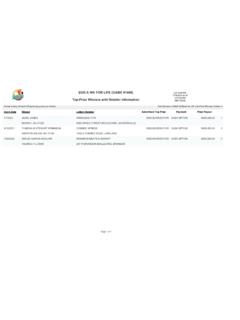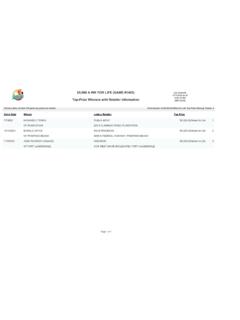Transcription of “WORKING” REMOTELY - Harvard University
1 WORKING REMOTELY ?SELECTION, TREATMENT,AND THEMARKETPROVISION OFREMOTEWORKN atalia Emanuel Emma Harrington1 This version: April 9, 2021 Latest Version: Click hereAbstract:Why was remote work rare prior to the pandemic? One possibility is that remote workreduced worker productivity. Another is that it attracted less productive workers. We test thesepossibilities in the call-centers of a Fortune 500 online retailer . We find that working REMOTELY in-creased call-center workers productivity. When previously on-site workers took up opportunitiesto go remote in 2018, their hourly calls rose by Similarly, when COVID-19 closed on-site callcenters, a difference-in-difference suggests that the productivity of workers who switched to re-mote work rose by relative to their already remote peers.
2 Despite these positive productivityeffects, remote workers were 12pp less likely to be promoted. If better workers are more concernedabout being overlooked in remote jobs, remote workers will be adversely selected. Consistent withthis theory, we find evidence that remote work attracted latently less productive workers. Whenall workers were remote due to COVID-19, those who were hired into remote jobs were 18% lessproductive than those who were hired into on-site jobs. Extending remote opportunities to on-site workers similarly attracted less productive workers to on-site jobs. The sorting of workersby ability meant some workers opted out of remote work because they did not want to pool withless productive workers.
3 This led to deadweight losses in the market for remote work. Lookingforward to life after the pandemic, our model suggests that COVID-19 could attenuate these lossesif firms have learned how to better evaluate remote workers or workers tastes for remote workhave become more : Harvard University , 1805 Cambridge Street, Cambridge, MA 02138, Wethank Nathan Hendren, Claudia Goldin, Lawrence Katz, Edward Glaeser, Louis Kaplow, Amanda Pallais, Elie Tamer,Jeff Liebman, and participants of the Public Finance and Labor Economics Workshop at Harvard for helpful are grateful to our colleagues, Lisa Abraham and Jenna Anders, as well as Alex Albright, Dev Patel, Ashesh Ram-bachan, Ljubica Ristovska, and Hannah Shaffer.
4 This project would not have been possible without the curiosity andcommitment to research of our colleagues at the firms who shared data: Lauren and Trevor. We are grateful for fi-nancial support from the National Science Foundation [Natalia] and the Lab for Economic Applications and findings and conclusions expressed are solely those of the authors and do not reflect the opinions or policy of theorganizations that supported this & HarringtonApril 9, 2021I INTRODUCTIONP rior to Covid-19, only 5% of Americans worked REMOTELY all of the few months into thepandemic, most workers who could work REMOTELY did so (Brynjolfsson et al.)
5 , 2020).3So, what wecan expect once the pandemic subsides? The answer to this question hinges on why remote workwas so rare prior to possibility is that working REMOTELY reduces productivity. Another possibility is that remotejobs attract latently less productive workers. If better workers are more concerned about beingoverlooked for promotion when out of earshot of their managers, remote workers will be ad-versely this paper, we test these possibilities using data from the call-centers of a Fortune 500 onlineretailer. Call-center work is an easily "remotable" job and one that has been the focus of existingscholarship on remote largest experiment on preferences for remote work was run ina US call-center (Mas and Pallais, 2017) and the largest experiment on its productivity effects wasrun in a Chinese call-center (Bloom et al.
6 , 2015).Mas and Pallais (2017) find that call-center workers are willing to accept 8% lower wages to havethe option to work REMOTELY . Given the low rates of remote work among call-center workers, thishigh willingness to pay suggests remote work is costly for firms. However, Bloom et al. (2015)finds no such costs, with remote work increasing productivity by 14% (Bloom et al., 2015).We see the same disconnect during the pandemic. The majority of workers report being happierand more productive working REMOTELY , but few firms have started to advertise jobs that will bepermanently remote (PwC, 2020; Morning Consult, 2020; Barrero et al.
7 , 2020; Ovide, 2021).5We argue the missing piece to this puzzle is career concerns. Indeed, in Bloom et al. (2015) sexperiment, remote work halved workers chances of promotion, opening up the possibility ofunraveling: remote jobs may become dead-end jobs that only attract workers who are unlikely to2In the 2018 American Community Survey (ACS), of workers reported working from home (based on theauthors calculations). In the American Time-Use Survey between 2013 and 2017, of workers reported spendingsome time working from home and reported spending the entire day working REMOTELY that day (Brynjolfsson etal.
8 , 2020). Since 2000, the share of workers working REMOTELY has been fairly constant despite continued innovation incommunication technologies, as illustrated in Figure (Mas and Pallais, Forthcoming). Oettinger (2011) found thathome-based work expanded substantially between 1980 and 2000, albeit starting from a very low estimates are also complementary with those from the Bureau of Labor Statistics, where 35% of workersreport working REMOTELY because of the has become clear during the pandemic, a large share of jobs are remotable. While many jobs cannot be donefrom afar it s hard to clean houses, move furniture, or flip burgers REMOTELY other jobs don t involve any of theseneeds to be in-person.
9 Dingel and Neiman (2020) use O*Net information about occupations to classify each occupationas either having an in-person need or being remotable. This analysis suggests that 37% of jobs were remotable in theUS at the outset of the two surveys of 2,207 remote workers, 32% report wanting to remain fully remote after the pandemic and 56%report wanting to work REMOTELY for more than half their week (PwC, 2020; Morning Consult, 2020). Similarly, in aZipRecruiter survey, 45% say they want a job that would let them be permanently remote. However, only 8 or 9% ofjobs are actually permanently remote, up just 6pp from before the & HarringtonApril 9, paper builds on the nascent literature on remote work by providing new estimates of theproductivity effects and promotion penalties of remote work in the US context.
10 We develop a two-period model that incorporates workers career concerns. This model predicts that differences inpromotion opportunities will lead to differences in worker selection. We then test this predictionempirically, offering the first analysis of productivity differences between workers who are hiredinto comparable remote and on-site jobs. Natural experiments at the retailer allow us to separatelyidentify the treatment and selection effects of remote work. We pull these estimates together toquantify the inefficiencies that arise from adverse selection into remote work. We organize theseanalyses into three first part provides descriptive evidence on the relationship between remote work and promo-tion, which then motivate a model of the choice to be remote or on-site that turns on career con-cerns.















